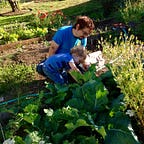Springtime Foraging in the Pacific Northwest
Let the games begin!
Nettles (Urtica dioica) blanched, ready for freezing. We’ll eat the tops year-round, but nothing beats the spring flavor of nettles.
Pacific waterleaf (Hydrophyllum tenuipes). Leaves and rhizomes edible in Spring. Been wanting to try them for some time, but never found a patch large enough that I was comfortable harvesting them since it also requires digging out rhizomes. This year I found a healthy community that could suffer some browsing.
Very tasty sauteed, especially with a little citrus flavor (key limes, in our case). We’ll definitely be adding these to the spring greens rotation, and will also try later in the year (reportedly they’re fuzzier then, so we’ll see what happens).
Purple Dead Nettle (Lamium purpureum). This stuff pops up everywhere, and has volunteered in my garden this year. It has a very mild flavor — it’s more for adding ‘bulk’ or substance to a dish, but works nicely in soups, stir fries, pestos, etc.
Fiddleheads from a Western Sword Fern (Polystichum munitum). This was something of an experiment, as they’re not generally eaten and are listed in some places as toxic. Apparently this is because they’re frequently confused with one of the other different “Sword Ferns.”
A key rule when cooking fiddleheads — almost all of which are slightly carcinogenic when eaten in quantity — is to boil them for some time prior to cooking. This shows our fiddleheads after a 15 minute boil. The brown hairy bits are the sheath around each one; this sheathe is fairly difficult to remove from sword ferns. Gentle rubbing gets most of the stuff off, but I ended up just tossing a number of the fiddleheads into the pan with the fuzz included — it didn’t seem to matter too much.
Since I’d never had these before, I tried two then waited 24 hours. No ill effects, so we cooked the rest in butter and served with pasta. Yum!
A healthy amount of fireweed shoots (Epilobium angustifoila) next to a big batch of Siberian Miner’s Lettuce (Claytonia sibirica). The miner’s lettuce is versatile, but delicate. It works best raw; use in tacos or anywhere you’d use fresh lettuce.
Fireweed is a huge favorite. We sautéed with garlic and scallions in olive oil and butter, served with vegetarian beef over pasta, with a dollop of full-fat plain yogurt and pickled mashua for a little “zing”!
Fireweed is also a multi-season wild edible that tastes great in most of its stages if you know how to harvest it:
These are just a few of the local edible delights popping up in and around Seattle this spring. If you’re a fellow forager, please feel free to share what you’re finding, and how you’re preparing it, in the comments!
